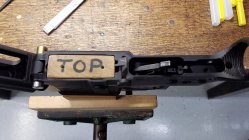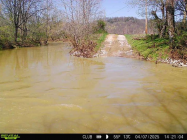You are using an out of date browser. It may not display this or other websites correctly.
You should upgrade or use an alternative browser.
You should upgrade or use an alternative browser.
AR Accurizing
- Thread starter LVLAaron
- Start date
Seeing as how he's going to have to face down the Loch Ness Monster to access his range Creedmoor is the only answer!Couldn't ya just put some kinda Creedmoor barrel on it and call it good?jd
what specs are you referring to? The TDPs I have looked at have same specs.Sure. I think the old mil spec parts were (on the whole) from consistent vendors that held tolerance.
I think the earlier specs on the M16 were much tighter clearances than later when they opened everything up for sand and dirt.
ELR LVR
Silver $$ Contributor
I've read about guys securing the barrel in the receiver with LoctiteI've always been a big advocate for bedding the barrel with loctite, or using a shrink fit upper
I just can't imagine having to remove it later and the possible heat damage due to how hot it must get to soften the loctite.
I don't understand why guys don't bed with JB and mold release the upper instead?
Loctite 620 is a sleeving compound. Wooden dowel rod and mallet knocks barrel out pretty easily.I've read about guys securing the barrel in the receiver with Loctite
I just can't imagine having to remove it later and the possible heat damage due to how hot it must get to soften the loctite.
I don't understand why guys don't bed with JB and mold release the upper instead?
Fast14riot
Gold $$ Contributor
Blue locktite has been my choice for bedding barrel extension to receiver (within reason), bedding gas block to journal and gas tube to block.
ELR LVR
Silver $$ Contributor
Got it, thanks guys, didn't know.Blue locktite has been my choice for bedding barrel extension to receiver (within reason), bedding gas block to journal and gas tube to block.
The guy in the video said he uses GREEN, so just figured....
One of my bosses was a mechanic at Ford once before
And in one of their memo updates they suggested locking a certain part with green
which according to their testing was the equivalent strength, the same as welding
which is why I was like "He Does WHAT with the barrel with green loctite?"
----------------------------------
I have had to remove parts secured with green and it takes an Oxy/Acetylene torch
Propane dont cut it
and oxy/acetylene will melt aluminum
----------------------------------
So you can imagine my concerns
I don't understand why loctite is such a mystery for guys.

 next.henkel-adhesives.com
next.henkel-adhesives.com
Sure you can use threadlocker to bed the barrel extension, but why not use the product specifically designed for that use?
Retaining solutions
Retaining compounds reliably secure bearings, keyways and cylindrical parts into housings or onto shafts. LOCTITE® retaining compounds offer an effective and economical method to eliminate challenges such as loosening, corrosion, backlash and wearing by providing uniform stress distribution and...
Sure you can use threadlocker to bed the barrel extension, but why not use the product specifically designed for that use?
LVLAaron
Gold $$ Contributor
I'm gonna be that guy and remind everyone to refer to loctite by it's number. There are lots of different "greens"
Anyway.
The very gun I'm working on had the barrel bedded with loctite. It's not to too hard to remove. Once the barrel is out, dremel and a little wire brush attachment clean everything up just fine
Anyway.
The very gun I'm working on had the barrel bedded with loctite. It's not to too hard to remove. Once the barrel is out, dremel and a little wire brush attachment clean everything up just fine
Loctite is easily defeated with heat, Doesn't matter what number, Heat will loosen it.
ELR LVR
Silver $$ Contributor
My experience with High Strength, High Temp Loctite (620 being one)Loctite is easily defeated with heat, Doesn't matter what number, Heat will loosen it.
has been with the removal of the spiders and lock nuts on Polaris ATV UTV and Snowmobile Drive Clutches
It has to be heated so much that a few times the aluminum almost starts to sag, melt, give way etc
(Big Alum Part drawing all the heat away but heat must still be applied locally to the area until the bond breaks)
or has to be heated repeatedly because it starts to harden right back up once you get about half a turn
if it is not hot enough, and you try to loosen the spider or lock nut, the threads strip
so theres a fine line between hot enough and too hot
(when it comes to Aluminum parts anyway)
---------------------
maybe its a different story with with sleeved parts as opposed to threaded and torqued down?
Im just surprised after dealing with a few stripped clutches from not enough heat to hear a knock with a mallet will loosen a high strength sleeve retainer,
when a sleeve retainer is suppose to retain a sleeve with high strength lol?
I've gotten out a lot of red loctite 620 scope base screws that some bozo used it on by using the smallest oxy acetylene welding tip I have and heat the top of the screw for a couple few seconds is enough to break them loose.My experience with High Strength, High Temp Loctite (620 being one)
has been with the removal of the spiders and lock nuts on Polaris ATV UTV and Snowmobile Drive Clutches
It has to be heated so much that a few times the aluminum almost starts to sag, melt, give way etc
(Big Alum Part drawing all the heat away but heat must still be applied locally to the area until the bond breaks)
or has to be heated repeatedly because it starts to harden right back up once you get about half a turn
if it is not hot enough, and you try to loosen the spider or lock nut, the threads strip
so theres a fine line between hot enough and too hot
(when it comes to Aluminum parts anyway)
---------------------
maybe its a different story with with sleeved parts as opposed to threaded and torqued down?
Im just surprised after dealing with a few stripped clutches from not enough heat to hear a knock with a mallet will loosen a high strength sleeve retainer,
when a sleeve retainer is suppose to retain a sleeve with high strength lol?
ELR LVR
Silver $$ Contributor
well ok that makes more sense, theres not a lot of surface area involved thereI've gotten out a lot of red loctite 620 scope base screws that some bozo used it on by using the smallest oxy acetylene welding tip I have and heat the top of the screw for a couple few seconds is enough to break them loose.
skeeljc
Gold $$ Contributor
Here are my methods of tightening the upper/lower AR receivers:
1. Ream and install a 1/4" shoulder bolt in the front pivot.
2. Ream the rear pin holes and install an oversized pin.
3. Drill and tap a hole in the lower receiver to install a set screw to push against the upper at the rear pin location (Aero Precision lowers have this feature).

1. Ream and install a 1/4" shoulder bolt in the front pivot.
2. Ream the rear pin holes and install an oversized pin.
3. Drill and tap a hole in the lower receiver to install a set screw to push against the upper at the rear pin location (Aero Precision lowers have this feature).

Last edited:
A high temp soldering iron works on screws like this too. I repaired MANY poorly mounted stripped screw red dot pistol optic mounts this way.I've gotten out a lot of red loctite 620 scope base screws that some bozo used it on by using the smallest oxy acetylene welding tip I have and heat the top of the screw for a couple few seconds is enough to break them loose.
I always face the upper receiver face in the lathe w/ a mandrel through the bolt/carrier raceway to ensure a good square surface for the barrel extension. I bed the extension w/ red (stud bearing formula) loctite. Getting a barrel out involves a brass drift that’s a slip fit through the receiver and a 3lb aluminum mallet. Don’t really have to take many out though. Basically a top quality barrel that i chamber myself, and a decent two stage trigger and they shoot extremely well. I might just try that carrier shim in the back though…interesting.
ELR LVR
Silver $$ Contributor
I like all these ideas very muchHere are my methods of tightening the upper/lower AR receivers:
1. Ream and install a 1/4" shoulder bolt in the front pivot.
2. Ream the rear pin holes and install an oversized pin.
3. Drill and tap a hole in the lower receiver to install a set screw to push against the upper at the rear pin location (Aero Precision lowers have this feature).
View attachment 1651045
I don’t mind him at all and like his vids.If you can tolerate him, Chad at School of the American Rifle has some interesting stuff. The guy gauges everything. He's been doing a mystery shopper series where he buys 10 of the same rifles from Ruger, M&P, etc and checks them all in great detail. Spoiler; the results aren't awesome.
Similar threads
- Replies
- 10
- Views
- 2,436
- Replies
- 20
- Views
- 1,260
Upgrades & Donations
This Forum's expenses are primarily paid by member contributions. You can upgrade your Forum membership in seconds. Gold and Silver members get unlimited FREE classifieds for one year. Gold members can upload custom avatars.

Click Upgrade Membership Button ABOVE to get Gold or Silver Status.
You can also donate any amount, large or small, with the button below. Include your Forum Name in the PayPal Notes field.
To DONATE by CHECK, or make a recurring donation, CLICK HERE to learn how.

Click Upgrade Membership Button ABOVE to get Gold or Silver Status.
You can also donate any amount, large or small, with the button below. Include your Forum Name in the PayPal Notes field.
To DONATE by CHECK, or make a recurring donation, CLICK HERE to learn how.










